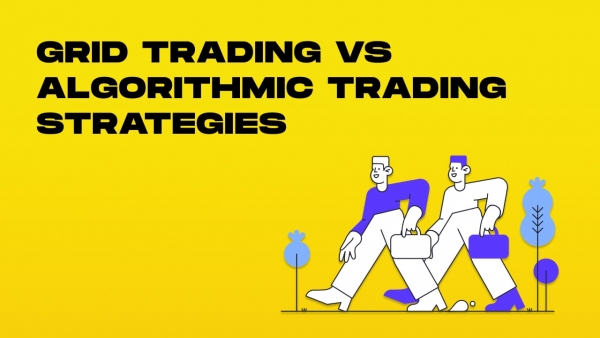Any trading robot is an algorithm. It follows strict instructions and never deviates from an established pathway carved out in “stone” by its user. The same can be said about a grid trading bot that operates on a set of instructions, albeit slightly more complex than a typical baseline robot. However, it is still just another form of advanced algorithmic trading system. Grid trading typically involves placing buy and sell orders at regular intervals above and below a central price or reference price, which is often set near the current market price.
We can still compare it to other custom algorithmic trading strategies as it has some distinct features and does not fall in the same category as many other custom-made robots. When comparing grid trading to other algorithmic trading strategies, a unique aspect is the systematic approach of placing buy and sell orders around a central price, using the reference price or current market price as the basis for order placement. One of the key differences is that grid bots are positioned as separate products by countless automation providers and usually have standard settings and baseline functionality.
Grid trading vs algorithmic trading for beginners
A good GRID trading system often relies on the right quantitative trading approach as you need to use various analytical methods to identify good moments to activate bots and allow them to do their job. Running any automated trading systems all the time regardless of market conditions is not a good idea as circumstances change and can drastically influence the effectiveness of any given trading system.
It is important to recognize that this financial technology is still being improved and developed despite the fact that many retail traders often believe that there is nowhere else to go. Automation is incredibly popular and makes it close to impossible to compete against the market without using it to at least some degree. Even newcomers often come equipped with some basic knowledge of trading automation.
It means that many are closely familiar with the concept of algorithmic trading and can build simple automated trading systems with the help of contemporary automation providers that often simplify the scripting and bot building in general to make it even easier for novices to use robots. The product of customized robots competes against preset solutions like DCA, AI-assisted arbitrage, and GRID.
Here are some important differences that you should consider when choosing which type of an automated trading system to use:
-
GRID bots have unique settings to work with. With some additional tinkering, you can create a custom bot that will work just like a typical grid robot. However, you will need to go an extra mile instead of simply adjusting settings of an existing bot that already has everything else tuned for efficient performance.
-
GRID, as a system, has been tested by many users. One of the reasons for companies to keep pushing this product into the masses is that it works better than many other automation instruments offered by vendors. Algorithmic trading is not as simple as it seems. Many retail traders fail to build effective custom systems and ultimately lose money. Users of grid bots often come out on top even if with just a relatively small profit.
-
Once activated they do not need any supervision. Since grid bots create buy and sell orders simultaneously, users do not have to keep a close eye on them once they are triggered by a trading signal. Grid trading offers a systematic approach that reduces the need for constant monitoring, making it ideal for beginners. When market conditions are favorable, you can expect these robots to deliver consistent results even if you don’t pay much attention to what they are doing in the moment. Grid trading strategies are designed to generate consistent profits by improving trading efficiency through automation.
In many ways, it is much easier for newcomers to work with preset solutions like grid or DCA since they can work even if you mess up trading signals and activate them in a relatively unfavorable situation. These preset bots are way more forgiving and allow some room for experimentation. People without any prior exposure to the crypto trading market should try using grid or DCA systems.
How to choose the right trading strategy
Unfortunately, over 60% of all retail traders ultimately lose money in the long term due to making bad investment decisions, failing to recognize promising opportunities, or succumbing to stress and negative emotions. Even if you use the safest approach to investing, there is still a very high chance of ruining a portfolio in just a couple of bad trades executed at the wrong time.
Finding the right analytical strategy is quite important for any trader. Even if you run an algorithmic trading bot and do not actively place orders, you still need to use a strategy to identify a good moment to trigger them.
GRID bots follow a predetermined path, but they must start it somewhere. Trading along a strong trend without unexpected price deviations is usually the best case. There are some technical analysis methods that can help you identify favorable periods for trading. Trend trading strategies rely on identifying market trends using indicators like MACD and Bollinger Bands. Understanding market trends is crucial for selecting the appropriate trading strategy.
Here are some of them:
-
Bollinger Bands (BB) breakouts. This indicator shows a price channel formed by moving averages of standard deviation of the price in both directions. Breakouts can be evidence for trend reversals or strengthening depending on the context. For example, if the price deviates in the direction of the trend, it may indicate that it gains strength. On the contrary, a breakout in the opposite direction is often a good indication that the market is changing course, at least temporarily.
-
Moving Average Convergence/Divergence (MACD) helps you identify when a trend is getting stronger. When all lines diverge, it means that the market made its decision and moves further with the established trend. When lines begin diverging, it can be a good moment to activate a grid bot or another algorithmic system that benefits from trading along a strongly developed trend. Use MACD together with BB or Relative Strength Index (RSI) to find good trading opportunities.
-
On-Balance Volume (OBV) is an important tool to analyze the current market situation. It provides context to changing trading volume numbers by calculating the strength of pressure from bulls and bears. In normal conditions, this indicator is used to confirm trends. When it goes up alongside rising prices or falls down during bear markets, it means that a trend is strengthening. Use it in conjunction with other analytical instruments like RSI and BB to identify good moments to trigger bots.
Choosing the right strategy can be a challenging task as it requires you to go through a lengthy period of trial and error. Thankfully, modern automation and analytical platforms have the necessary features to help you speed up the process with vigorous testing against the market history. You can use the “strategy tester” tool at TradingView or backtesting features of automation vendors like WunderTrading to use historical data of price change to test and optimize various analytical systems.
When choosing and testing trading strategies, it is essential to define the strategy aims and implement proper risk management. This helps ensure that your approach is aligned with your goals and that potential losses are controlled.
How to use grid trading effectively
Building a balanced portfolio is one of the most important skills for any investor. You should aim at protecting all market positions and create a composition of assets that have the lowest risk of failing while delivering acceptable profits in the long run. Grid bots can be imagined as a separate asset class as they can be applied to any market and generate profits in a predictable manner while being vulnerable to unique risks. Grid trading works by dividing a defined range into multiple price levels and placing buy and sell orders at those levels to capture profits from market fluctuations.
Here are some risks to be concerned with:
-
Technology failure. If you work with an unreliable company that does not have a robust digital infrastructure, you may experience service disruptions which can dramatically affect the outcome of your trading activities especially if you use leverage to create some market positions.
-
Sudden market events. A volatility spike caused by an unexpected crisis or breaking news can have a destructive effect on your investments. Robots do not perform well during chaotic periods when prices change suddenly. It is crucial to use risk management tools, such as stop-loss orders, to help prevent significant losses from sudden market movements or a losing trade.
-
High fees and commissions. The sheer volume of trades that your bots will produce is enough to create a large sum of fees that will bite into your profits. Frequent price movements and trade execution in volatile or highly volatile markets can lead to increased transaction costs. Make sure to adjust settings and set profitability goals with the cost of commissions in mind.
Any contemporary automated trading platform offers grid bots as one of their core products. This system is quite good and works better than many custom trading systems. However, you should be very careful when setting up a grid bot.
Diligently researching reliable technical analysis methods, selecting the right entry and exit points, testing every configuration using backtesting functionality, and focusing on building a consistently performing system should be your main goals. Using market data and historical price movements helps optimize grid parameters and adapt grid trading strategies to different market conditions, such as sideways or range bound markets.
Grid trading strategies are particularly effective in sideways and range bound markets with frequent price swings, as traders can capture profits from price fluctuates without needing to predict market direction to generate profits.
Doing it your way or using grid bots
Grid bots are reliable. They are based on the DCA approach and usually can produce small profits with an impressive level of consistency. However, DCA and GRID are not designed to make you rich. These are good hedging instruments and can be a stable source of passive income, but you still need to be proactive if your goal is to earn as much money as possible.
The problem is that you need some technical expertise, deep knowledge of technical analysis, and some other skills to build custom automated trading systems that can perform on par or better than an average human trader. If you are still learning and want to improve your skills before experimenting with various instruments offered by the industry of algorithmic trading, focusing on established and time-tested tools like grid bots is a good choice.
























